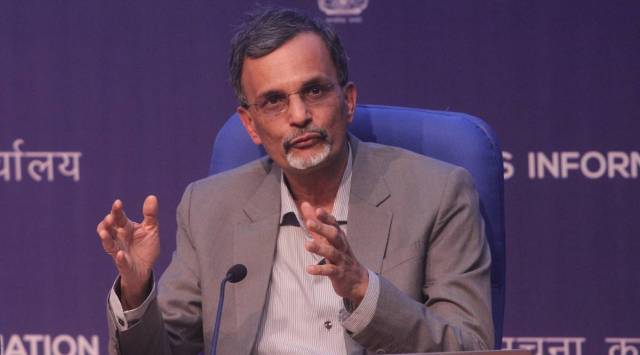India’s digital public infrastructure (DPI), which includes platforms like Aadhaar, the Unified Payments Interface (UPI), and the account aggregator network, can add around 60-100 basis points (bps) to the country’s potential GDP growth rate, chief economic advisor V Anantha Nageswaran said Tuesday.
“There is lots of justified optimism about India’s digital public infrastructure. The digital infrastructure can help the hitherto excluded sections get a fair shot at accessing national and international markets,” Nageswaran said while presenting the Economic Survey for 2022-23 tabled in Parliament.

According to the Survey, payments made through UPI accounted for over half of all digital transactions in India in FY22 (2021-22).
“In FY22, UPI accounted for 52 per cent of the total 8,840 crore financial digital transactions with a total value of Rs 126 lakh crore,” the Survey said.
Between FY19-22 (calendar year), UPI transactions grew 121 per cent in value and 115 per cent in volume, the Survey noted. In December 2022, UPI touched its highest-ever mark with 782 crore transactions worth Rs 13 lakh crore.
The Economic Survey also said that UPI had processed 2,922 crore contactless merchants’ transactions with a total value of over Rs 21.7 lakh crore in the first nine months of FY23 (2022-23). More than 380 banks had become a part of UPI as of December 2022, from 35 in December 2017.
Highlighting the increasing number of digital transactions being done in the country, the Survey said that the country had a fintech adoption rate of 87 per cent among the public, compared to the global average of 64 per cent, making India the third biggest market for such transactions after the US and China.
“In 2009, only 17 per cent of adults in India had bank accounts, 15 per cent used digital payments, 1 in 25 had a unique ID document, and about 37 per cent had mobile phones. Today, these numbers have seen a meteoric rise — tele density has reached up to 93 per cent, over a billion people have a digital ID document, more than 80 per cent have bank accounts, and as of 2022, over 600 crore of digital payment transactions are completed per month,” the Survey said.
Story continues below this ad
Under the digital identity system Aadhaar, which was launched in 2009, about 135.2 crore Aadhaar numbers were generated as of November 2022, which saw 8,621 crore authentications be done via Aadhaar and 1,350 crore eKYC transactions. 75.3 crore residents have linked their Aadhaar with ration cards to avail ration while 27.9 crore residents have linked their Aadhaar with cooking gas connections to receive LPG subsidies, the Survey said.
About 75.4 crore bank accounts are linked with Aadhaar and 1,549.8 crore transactions have taken place via Aadhaar Enabled Payment Systems (AePS). More than 300 central schemes and over 700 Direct Benefit Transfer (DBT) schemes of various state governments use Aadhaar for the targeted delivery of financial services, subsidies, and benefits to citizens. Multiple large central schemes, including PAHAL, and MGNREGS have paid over Rs 7,66,055.9 crore through over 1,010 crore successful transactions until November 2022, the Survey said.
The Survey noted that the creation of digital identities such as Aadhar, registration of unorganised workers on the e-shram portal, street vendors on SVANidhi, taxpaying firms on GSTN, and MSMEs on the Udayam portal, has played a significant role in the inclusion of these groups under the formal economic net.
“As an illustration, we can now track that out of the 1.27 crore enterprises registered on the Udyam Portal, more than 93,000 micro-enterprises have grown to become small enterprises, and 10,000 small enterprises have become medium enterprises over the last two years,” said the Survey.
Story continues below this ad
“Creating an identity has also simplified and enabled access to formal credit for many of these groups. More than 32.7 lakh street vendors have availed of a first loan of Rs 10,000 under the PM SVANidhi Scheme, and of these, more than 6.9 lakh have availed a second loan of Rs 20,000. Moreover, digital systems such as the Goods and Services Tax Network (GSTN) and e-Way Bill system have enabled the formalisation of business transactions. The increasing number of GST taxpayers, from 70 lakh in 2017 to more than 1.4 crore in 2022, indicates the expansion in formal businesses,” it added.
Highlighting the Reserve Bank of India’s regulated data sharing system, the account aggregator framework, the Survey said that more than 1.1 billion bank accounts are now eligible to share data under the network, and around 3.8 million users have successfully shared data via the platform.
“With 23 Banks onboarded to the Account Aggregator framework, more than 1.1 billion bank accounts are eligible to share data on AA…3.3 million users have linked their accounts to the AA framework out of which 3.28 million users successfully shared data via AA,” the Survey said.
As of December 2022, 27 financial institutions have gone live on the account aggregator network, including all 12 public sector banks, 10 private sector banks, one small finance bank, and four life insurance companies, the Survey said.









